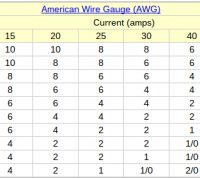Denny, are your distances one way or round trip.
When working with DC voltages the length has to be computed on a round trip.
The wire size is based on run length and line loss for a given current.
The fuse size is there to protect the wire and not the electronics. The fuse is larger than the current draw to support the current inrush from turning the unit on… (normally higher from steady state operation)
I don’t know where the chart came from but my guess is that it has an extremely high margin of safety built into it. The NEC (national electrical code) rates wire gauge ampacity differently.
The difference between marine wire and other stranded wire is the number of strands (usually higher strand count) for improved flexibility and vibration protection and tinned (for corrosion protection)
Your new sonar will probably run fine on marine stranded 14 gauge and I would install 12 gauge as a safety factor. Your experienced line loss will be less than 1/2 volt.
I am assuming you are running new separate wire pairs directly to the battery without any interruptions or additional taps. Solder the connections and protect them with shrink tube. Reduce the length of the supplied power cord (20-24 gauge) to within a foot or two of the unit.
